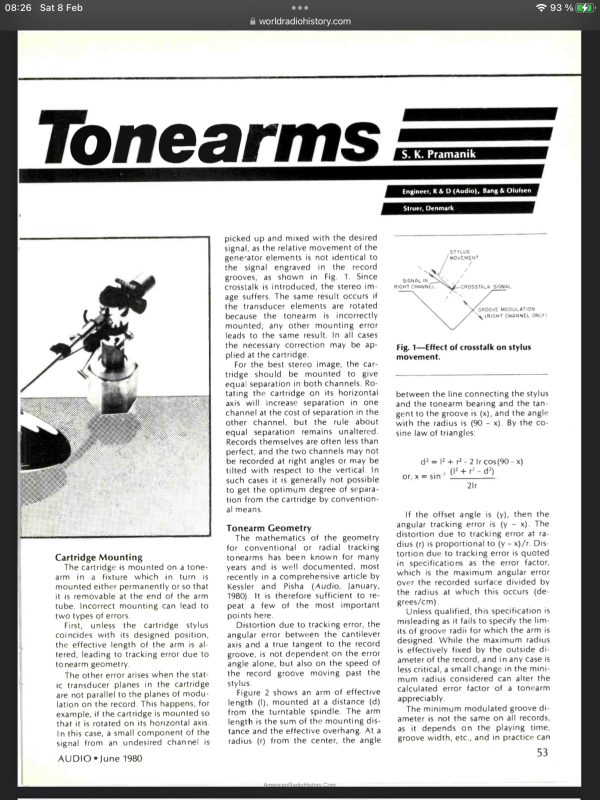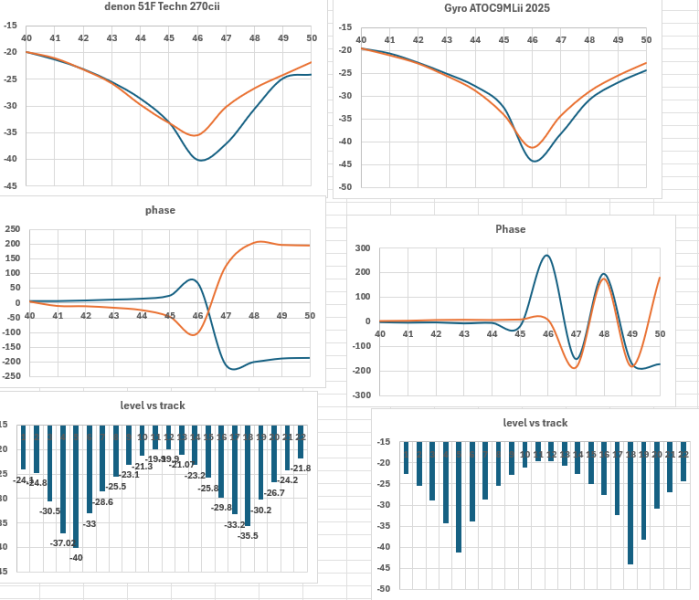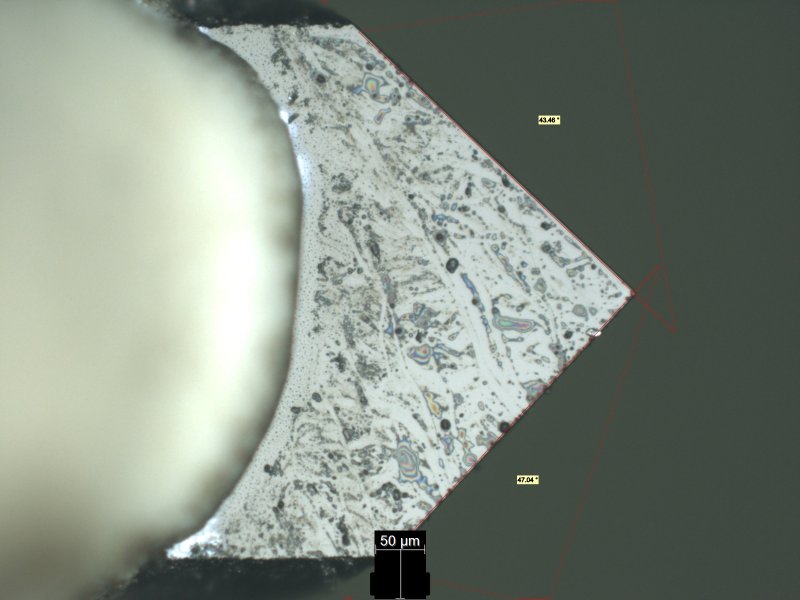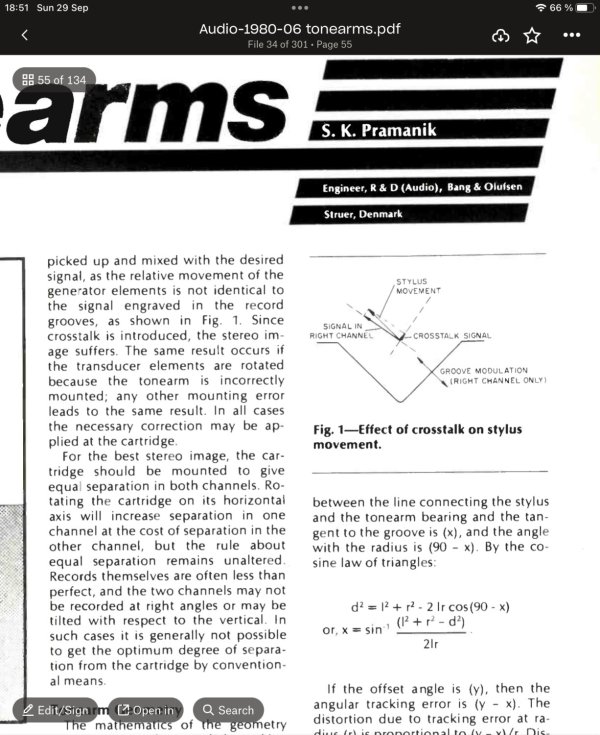Thanks. But - and forgive me if I am in error - it seems like you are using the Toshiba records to set Azimuth, but ignoring phase as part of this task.I is A lot of work to get the phase, but I gave that too somewhere, in ASR “Fun with vinyl measurements”. Much easier with AMagiknthat gives phase and db in one go….
Why is reading crosstalk so inconsistent across the different tools?
- Thread starter tony22
- Start date
You are using an out of date browser. It may not display this or other websites correctly.
You should upgrade or use an alternative browser.
You should upgrade or use an alternative browser.
I do not bother with phase, it takes Me hours to analyse and pick out phase. With AnalogMagik it is easier, but phase is different every time I run a track and vary a long track too , so so far I do not trust phase results much. I cannot use AMagik on the Toshiba record..too much work to get phase ..
I rather have good separation than care about the phase of the crosstalk signal . My understanding is that it will be in phase in one direction and out of phase in the other
This diagram may be helpful to evaluate Azimuth effekts.In this diagram I interpret the crosstalk signal to be IN phase, if angled more counter clockwise the crosstalk signal would be OUT of phase., For the Left channel the crosstalk starts here OUT of phase.
Ideally the Phase switches direction/ crosses when azimuth is perfect, and crosstalk minimum, but I guess Zenith and VTA complicates the response too..and the stylus may not be aligned with the coil/magnet complicating things further,
From the times when audio magazines was worth to read and actually had facts and information , not just subjective blabber and nonsense

This diagram may be helpful to evaluate Azimuth effekts.In this diagram I interpret the crosstalk signal to be IN phase, if angled more counter clockwise the crosstalk signal would be OUT of phase., For the Left channel the crosstalk starts here OUT of phase.
Ideally the Phase switches direction/ crosses when azimuth is perfect, and crosstalk minimum, but I guess Zenith and VTA complicates the response too..and the stylus may not be aligned with the coil/magnet complicating things further,
From the times when audio magazines was worth to read and actually had facts and information , not just subjective blabber and nonsense

Attachments
Last edited:
Crosstalk and phase vs groove angle -(Merolemez Hungaton test record) by using Analog Magic V1
Record has first Left groove signal for crosstakt to right at 50 to 40 degree modulation angle, then right channel high signal is modulated 40 to 50 degree. 45 degree is same as 90 degree azimuth of course. see text below . If Crosstalk is minimum at same degree alignment is good, ideally that happens at 45 degree , I always get 46 degrees,trying to match minimums at 45 degree is not successfully in my case
Left cartridge is set up using Ultimate Test record, right c with Toshiba



Record has first Left groove signal for crosstakt to right at 50 to 40 degree modulation angle, then right channel high signal is modulated 40 to 50 degree. 45 degree is same as 90 degree azimuth of course. see text below . If Crosstalk is minimum at same degree alignment is good, ideally that happens at 45 degree , I always get 46 degrees,trying to match minimums at 45 degree is not successfully in my case
Left cartridge is set up using Ultimate Test record, right c with Toshiba


Last edited:
Here is *part* of the answer as to why different records offer different crosstalk results. These are cutting styli we are analyzing. Notice the cutting facets are not 45 degrees to the centerline of the shank. Admittedly, you cannot see that measurement directly in these photos because prior to the final (top, "Step 4") photograph we confirmed the stylus was completely orthogonal to the frame within +/- 0.15 degrees (conservatively). We then zoomed in and measured the cutting facets against the frame. It should be 45 degrees, of course. This is NOT the worst we have seen.
These are not stacked photos. Such photos are NOT reliable to take measurements from.
Of course, this situation is also NOT a reason to throw our hands up into the air and declare the effort of optimizing for maximum channel separation and phase balance is fruitless. It is completely worth the effort due to the tendency for the statistical error of such cuts and cutting styli to be symmetrical about the mean of the distribution of all cuts! HOWEVER, it is also still an excellent reason to distrust any test record which cannot first provide for you how the engineers controlled, measured and maintained their own cutting accuracy on all four angles, the cutting path itself and the symmetry of the cutting stylus. Until then, enjoy the music, but don't trust the records to put your alignment at the mean of the distribution of all errors.

These are not stacked photos. Such photos are NOT reliable to take measurements from.
Of course, this situation is also NOT a reason to throw our hands up into the air and declare the effort of optimizing for maximum channel separation and phase balance is fruitless. It is completely worth the effort due to the tendency for the statistical error of such cuts and cutting styli to be symmetrical about the mean of the distribution of all cuts! HOWEVER, it is also still an excellent reason to distrust any test record which cannot first provide for you how the engineers controlled, measured and maintained their own cutting accuracy on all four angles, the cutting path itself and the symmetry of the cutting stylus. Until then, enjoy the music, but don't trust the records to put your alignment at the mean of the distribution of all errors.


Great work, J.R., but I have to sadly disagree with what you said (that I italicized above), because of… what you said (that I bolded above)!It is completely worth the effort due to the tendency for the statistical error of such cuts and cutting styli to be symmetrical about the mean of the distribution of all cuts! HOWEVER, it is also still an excellent reason to distrust any test record which cannot first provide for you how the engineers controlled, measured and maintained their own cutting accuracy on all four angles, the cutting path itself and the symmetry of the cutting stylus. Until then, enjoy the music, but don't trust the records to put your alignment at the mean of the distribution of all errors.
I submit that it is more likely I poorly worded my comment than it is for us to disagree on what I was TRYING to articulate rather hastily.Great work, J.R., but I have to sadly disagree with what you said (that I italicized above), because of… what you said (that I bolded above)!
While we don’t represent a majority, between me, Balle, you, and maybe one or two others here, we have enough test records (probably over 50, including copies) to know that relying on any one random selection is hopeless - if truth in alignment is what we’re after.
The comment you italicized was simply to suggest that aligning azimuth per se - by using a random test record - is better than not doing it at all.
Do you think that is a fair claim?
Agreed. There is always more to get from the groove.Yes, of course.But we know those of us focused on this topic are… let’s say maniacs.
Acceptable is not good enough!
Since my Toshiba test record gives a result close to the median of my 30+test records I rely on that, but I could have used the Ultimate test record too without to much error, Ortofon test record is OK too.. but some like Tacet are so far off from the others that it is not trustworthy..
Listening to a properly equalised CA TRS-1007 sweep and noticing the crosstalk is a revealing experience, poor crosstalk becomes very annoying indeed..and arm resonances (>20hz) can pop out like beeps in the crosstalk channel! ( but barely audible in the main channel)
See also the “Yellowed” quote in post 45 , I find that interesting..
Listening to a properly equalised CA TRS-1007 sweep and noticing the crosstalk is a revealing experience, poor crosstalk becomes very annoying indeed..and arm resonances (>20hz) can pop out like beeps in the crosstalk channel! ( but barely audible in the main channel)
See also the “Yellowed” quote in post 45 , I find that interesting..
Last edited:
Dear @J.R. Boisclair ,
I appreciate your effort in testing these often-overlooked details and sharing your findings with us. However, I must say that you are not correct on this -actually, very far from it.
Azimuth is directly related to the alignment of the coils inside the cutterhead. The 45/45 geometry that Westrex invented and adapted for stereo records is not directly related to the angle of the facets of the cutting stylus, but the orientation of the coils and rods. Before the stereo era, the shape of the cutting stylus was also resembled a sharp arrow with 45-degree facets. This design was intended to cut the lacquer effectively, much like a chisel. However, its shape is not directly related to azimuth. I could use a U-shaped stylus instead of a regular arrow-shaped one and still cut a stereo lacquer. As long as the cartridge can properly follow the groove undulations, I can play that disc with perfect azimuth.
The 45/45 angle represents the orientation of the coils. As long as the coils are aligned at 45 degrees relative to the record surface and 90 degrees relative to each other, the cutterhead will cut the lacquer with perfect azimuth. Another crucial factor is the alignment of the rods connected to the coils -they must be precisely aligned same direction with the coils for optimal performance.
Please consider this.
I appreciate your effort in testing these often-overlooked details and sharing your findings with us. However, I must say that you are not correct on this -actually, very far from it.
Azimuth is directly related to the alignment of the coils inside the cutterhead. The 45/45 geometry that Westrex invented and adapted for stereo records is not directly related to the angle of the facets of the cutting stylus, but the orientation of the coils and rods. Before the stereo era, the shape of the cutting stylus was also resembled a sharp arrow with 45-degree facets. This design was intended to cut the lacquer effectively, much like a chisel. However, its shape is not directly related to azimuth. I could use a U-shaped stylus instead of a regular arrow-shaped one and still cut a stereo lacquer. As long as the cartridge can properly follow the groove undulations, I can play that disc with perfect azimuth.
The 45/45 angle represents the orientation of the coils. As long as the coils are aligned at 45 degrees relative to the record surface and 90 degrees relative to each other, the cutterhead will cut the lacquer with perfect azimuth. Another crucial factor is the alignment of the rods connected to the coils -they must be precisely aligned same direction with the coils for optimal performance.
Please consider this.
I know that the 45/45-degree relationship between the groove walls may come to mind, but it is not the most important factor in azimuth. One groove wall could be at 43 degrees and the other at 47 degrees relative to the record surface, yet as long as the movement inscribed on those grooves by the coils inside the cutterhead remains precisely at 45/45 degrees, the azimuth will be spot on. The only difference will be that the stylus of the cartridge will land at slightly different locations on the left and right groove walls, respectively.
We are talking about two different things and I don’t think we fundamentally disagree at all. You are correct with your point about the thrust rod 45 degree orientation, but I am not referring to that.Dear @J.R. Boisclair ,
I appreciate your effort in testing these often-overlooked details and sharing your findings with us. However, I must say that you are not correct on this -actually, very far from it.
Azimuth is directly related to the alignment of the coils inside the cutterhead. The 45/45 geometry that Westrex invented and adapted for stereo records is not directly related to the angle of the facets of the cutting stylus, but the orientation of the coils and rods. Before the stereo era, the shape of the cutting stylus was also resembled a sharp arrow with 45-degree facets. This design was intended to cut the lacquer effectively, much like a chisel. However, its shape is not directly related to azimuth. I could use a U-shaped stylus instead of a regular arrow-shaped one and still cut a stereo lacquer. As long as the cartridge can properly follow the groove undulations, I can play that disc with perfect azimuth.
The 45/45 angle represents the orientation of the coils. As long as the coils are aligned at 45 degrees relative to the record surface and 90 degrees relative to each other, the cutterhead will cut the lacquer with perfect azimuth. Another crucial factor is the alignment of the rods connected to the coils -they must be precisely aligned same direction with the coils for optimal performance.
Please consider this.
I am highlighting the risk of cutting crosstalk into the groove AS A RESULT OF STYLUS ASYMMETRY - which is one reason why test records differ in what they tell us to do on the playback side for playback azimuth adjustment.
A cutting stylus with 92 degrees cutting groove angle but with 46/46 degree channel facet angles will cause crosstalk cut into the groove but at least with the crosstalk being in phase with the main signal.
Alternatively, a cutting stylus with 90 degrees cutting groove angle but with 43/47 degree channel facet angles will cause out of phase channel crosstalk.
We cut lacquers for our own research and have modeled this for ourselves. Many lengthy conversations with multiple mastering engineers from US to Germany to Greece are involved with us on this very conversation. We see the limits of some cutterhead designs which prevent us from optimizing the system in an effort to achieve ideal cuts. It is frustrating and pays us nothing at all but the satisfaction that we are on the leading edge of the evolution of the format.
Similar threads
- Replies
- 92
- Views
- 13K
- Replies
- 63
- Views
- 21K
- Sticky
- Replies
- 13
- Views
- 37K
- Replies
- 10
- Views
- 9K
| Steve Williams Site Founder | Site Owner | Administrator | Ron Resnick Site Owner | Administrator | Julian (The Fixer) Website Build | Marketing Managersing |







